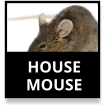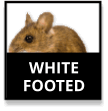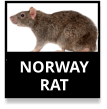WOOD RAT CONTROL WARMINSTER PA
Some people in Warminster know wood rats by another name, pack rats. Also called trade rats, members of this species are perhaps most recognized for their habit of collecting or packing around various shiny objects. Accordingly, it is not unusual for keys, rings and other small items to go missing during a wood rat infestation. The animals take these items and store them in their nests, which means that it may be possible to recover anything that has mysteriously gone missing.
The common name of this species also refers to their habit of "trading" whatever they might be carrying at the time for another, more interesting, object that they might come across during their foraging. Discovering that small items are missing frequently is one of the first clues people have that wood rats are at work on their property.
The wood rat's packing and trading habits might almost seem amusing if the animal were not so dangerous. Diseases run rampant wherever the species is present, and it is critical that people take steps to guard themselves against possible infection. Most people do not realize that they can become ill through contact with or exposure to fur that the animal has shed as well as its waste products. This means that it is essential for the building to be completely sanitized before it is safe to occupy.
Unfortunately, the process for evicting wood rats is not an easy one. Several avenues of attack are required, and the best way to ensure that the animals truly are gone is to work with a licensed pest management professional.
Able to access and use specialized products, exterminators can safely and efficiently end wood rat infestations. Additionally, these trained professionals repair damage and clean up all evidence of the infestation, restoring the building to hygienic conditions.
WHAT DO WOOD RATS LOOK LIKE?
Similar in size to Norway rats, wood rats chiefly are distinguished by their furry tails, which closely resemble squirrel tails. The species further is characterized by its oversized ears. Average adult wood rats measure approximately 18 inches long and are covered in gray or reddish-brown fur, though the feet may be white.
WHAT DO WOOD RATS EAT?
Members of the species gravitate toward vegetation and plant matter as their main sources of food. Buds, leaves, stems, fruit, seeds, acorns and nuts are among their most commonly eaten items. Fungi and tree bark frequently supplement their diet, and excess food may be stored in or near the nest against scarcity in the winter.
Wood rats wreak havoc in agricultural fields, residential gardens and commercial landscaping. Any rooms in which people eat, prepare or store food also are prone to infestation as even the merest trace of food is enough to tempt these pests. When living indoors, the animals will seek out many of the same foods that they eat in the wild, but they are happy to dine on bread, peanut butter, pasta and a variety of grains as well.
WHERE DO WOOD RATS LIVE?
Wood rats may be found virtually everywhere in North America, and their populations extend as far south as Honduras. In fact, there are more than 20 species of wood rat, so they are variously adapted to an assortment of environments and climates.
The living is easy for wood rats in Warminster with its relatively mild climate and population of people. Wood rats love to live with or at least close to human habitations because of the shelter and food that they provide.
Wood rats are known for constructing particularly large and complex nests that may feature many rooms. This helps to support their habit of collecting small items brought back from foraging. A rock crevice, shrub or woodpile can be the ideal nesting site, but when the wood rats come indoors, they are spoiled for nesting choices. Wall voids, soffits and attics are common nesting sites, but the animals may use cardboard boxes, cupboards and closets if these places are not frequently disturbed by people.
Sticks and plant matter are gathered and used to build the nest. Coins, jewelry, keys and other small, shiny objects may form part of the nest as well. The animals similarly gather shredded insulation and furniture stuffing to line their nests.
DAMAGE CAUSED BY WOOD RATS
These pests can be shockingly destructive. More than one yard has been destroyed by this animal's tireless foraging for food, and the damage is even more widespread when wood rats are able to come indoors. This is because they continue to chew and claw at construction materials and any items that may be kept in the buildings. Clothing and other textiles, books, documents, artwork and almost any other common object may be destroyed by the wood rat's teeth and claws.
Huge stores of food also may be contaminated as the wood rat looks for its next meal. Any food that shows evidence of the wood rat's presence, such as claw and teeth marks on packaging or waste products inside the food itself, must be destroyed.
Wood rats have been known to chew through electrical wires, shred mattresses and destroy upholstered furniture. Nesting in cars, air conditioners and pool equipment is common, and this habit may cause massive damage.
ARE WOOD RATS AGGRESSIVE?
A cornered wood rat will react with a surprising amount of aggression, which is why it is never advisable for people to try to confront or interact with these animals. People who do see wood rats are encouraged to simply let the animal go about its business and immediately call an exterminator.
Wood rats see people as threats, and they will use their claws and teeth to protect themselves. Serious injuries and the transmission of disease are possible in these attacks.
DO WOOD RATS CARRY DISEASE?
Wood rats and other rodents are recognized for the sheer number of diseases with which they may be infested. Many of these easily are transmissible to people. The plague, which is spread by bacteria, is carried by parasites that frequently use wood rats as hosts. Whenever a wood rat infestation is occurring, people are at risk for this illness.
The waste products of the wood rat may be carrying the beginnings of leptospirosis. This leads to meningitis in people, which can include failure of the liver and damage to the kidneys.
Tularemia also is regularly spread by wood rats. Highly contagious and potentially fatal, tularemia can be successfully treated with antibiotics.
HOW TO DETECT WOOD RATS
Signs of a wood rat infestation include:
- Various small objects are reported missing
- Marks from teeth and claws are discovered on various articles and surfaces
- Rodent droppings are found within the building
HOW TO PREVENT WOOD RATS
To help prevent wood rat issues the following steps should be taken:
- Eliminate indoor and outdoor clutter to get rid of hiding and nesting spots
- Prevent trees and plants from contacting building exteriors
- Use wire mesh, caulk and weather stripping to block possible entrances
- Ensure that yard debris piles and woodpiles are placed at least 20 feet away from buildings
- Opt for pest-proof food storage practices
- Clean any rooms where food is kept, prepared or eaten more frequently
HOW TO TREAT FOR RODENTS
Successful rodent control typically involves a series of steps, including trapping, poison baits, along with proper species identification.
Those who suspect a rodent problem should contact Newtown Termite & Pest Control. Our experienced pest control professionals know how to inspect a structure to determine the type and scope of the infestation involved. They will then execute the appropriate plan of action to resolve the specific rodent issue plaguing your home or business while identifying entry points to help protect against future problems.
GET THE FACTS
● RODENTS










